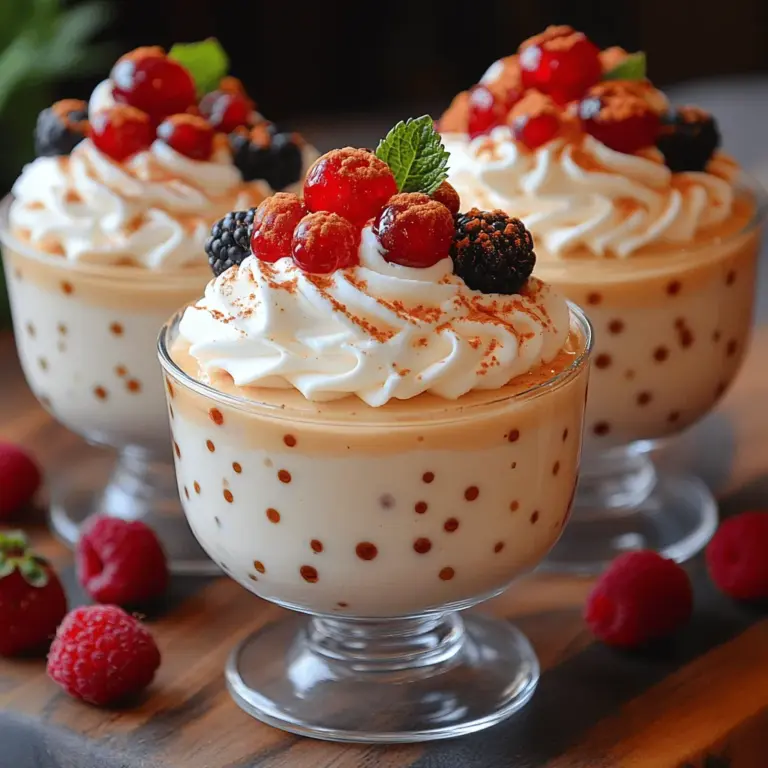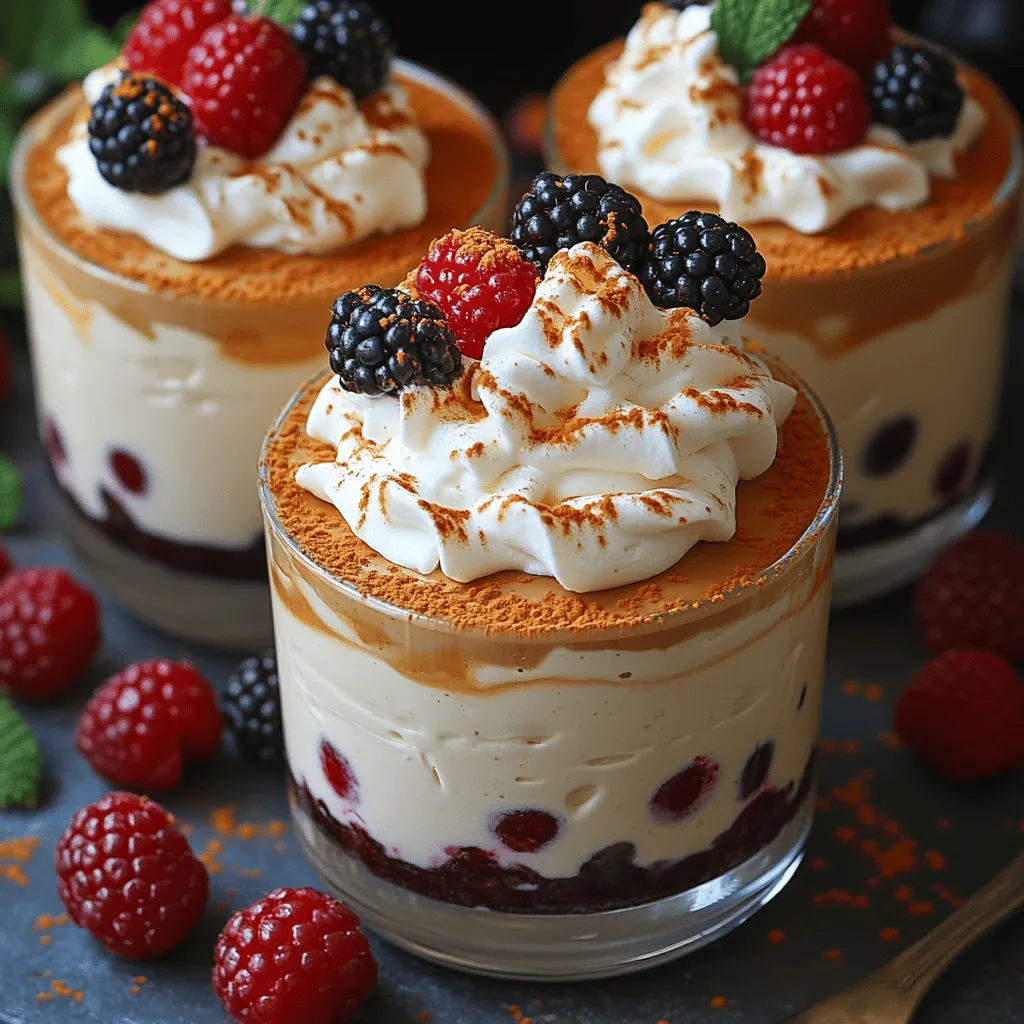Introduction
Indulging in a luscious dessert can elevate any meal, and few desserts exemplify this better than a creamy white chocolate mousse. This delightful treat is known not only for its rich, velvety texture but also for its ability to enchant palates with its delicate sweetness. The dreaminess of white chocolate mousse lies in its simple yet elegant composition, making it a beloved choice for special occasions and everyday celebrations alike.
White chocolate mousse has its roots in French culinary traditions, where it has been celebrated as a symbol of sophistication and refinement. This dessert showcases the versatility of white chocolate, which, despite its sweetness, can be artfully combined with various flavors and textures. Whether served as a standalone dessert or as part of an elaborate dessert platter, white chocolate mousse is sure to impress your guests and provide a memorable dining experience.
As we delve into this recipe, we will explore the essential ingredients and preparation techniques that contribute to the creation of this decadent mousse. With the right combination of fresh produce, quality proteins, and pantry staples, you can craft a mousse that not only tantalizes the taste buds but also embodies the essence of culinary artistry.
Understanding the Ingredients
Fresh Produce
While white chocolate mousse primarily revolves around the creamy sweetness of white chocolate, fresh produce plays a crucial role in elevating the dish. Incorporating fresh fruits, such as berries or citrus, can introduce a refreshing contrast to the richness of the mousse. Seasonal fruits not only enhance the visual appeal but also provide a burst of flavor that complements the smoothness of the chocolate.
Using fresh produce has numerous benefits. Seasonal fruits are often at their peak ripeness, which means they are packed with flavor and nutrients. For instance, strawberries in the spring and summer add a sweet-tart element that balances the sweetness of white chocolate, while citrus fruits like oranges or lemons can provide a zesty kick that brightens the overall flavor profile.
Herbs and Spices: Elevating Flavor Profiles
In addition to fruits, consider incorporating herbs and spices to enhance the mousse’s flavor complexity. A touch of sea salt can help highlight the sweetness of the white chocolate, while a hint of vanilla extract can add depth and warmth. For those looking to experiment, a sprinkle of cardamom or a dash of cinnamon can introduce an aromatic twist that transforms the classic mousse into a unique culinary experience.
Proteins
While white chocolate mousse is predominantly a dessert, it’s important to recognize the role of proteins in the overall preparation. Eggs are a key ingredient in traditional mousse recipes, contributing to the airy texture and richness. The use of egg whites, which are whipped to soft peaks, helps to create that light and fluffy consistency that is characteristic of a well-made mousse.
Choosing the right protein is essential for achieving the desired texture. If you prefer a lighter mousse, opting for only egg whites might be the way to go. Alternatively, for a richer dessert, incorporating the egg yolks can enhance the creaminess. Additionally, for those with dietary restrictions, plant-based alternatives, such as aquafaba (the liquid from canned chickpeas), can be whipped to create a similar airy effect.
Choosing the Right Protein: Meat, Poultry, or Plant-Based Options
While proteins like chicken or beef may not directly relate to this dessert, understanding their role in your culinary repertoire is important when considering a complete meal. If you’re serving the mousse after a protein-heavy main course, a lighter approach to the mousse can be refreshing. On the other hand, if your menu focuses on lighter proteins, such as fish or plant-based options, the richness of the mousse can serve as a satisfying finale.
Tips for Preparing Protein for Optimal Flavor
When preparing your proteins for the main course, consider complementary flavors that might also work well with your white chocolate mousse. For example, if you’re serving a lemon herb chicken, the citrus notes can echo in the mousse, particularly if you choose to incorporate citrus elements into the dessert. Marinating proteins with complementary herbs and spices can also create a cohesive dining experience.
Pantry Staples
In addition to fresh ingredients, having a well-stocked pantry is essential for any successful cooking endeavor. For white chocolate mousse, there are several key pantry staples that you will need to ensure a smooth preparation process.
Essential Condiments and Sauces
While the mousse itself doesn’t require many condiments, having high-quality vanilla extract is vital. This ingredient adds a rich flavor that balances the sweetness of the white chocolate. Additionally, you may want to keep a selection of sauces on hand, such as chocolate or fruit coulis, to drizzle over the mousse before serving.
Importance of Quality Oils and Vinegars
Although oils and vinegars may not be directly involved in the mousse, they play a significant part in your overall cooking experience. High-quality olive oil can be used in savory dishes leading up to dessert, while balsamic vinegar can be a surprising yet delightful addition to a fruit garnish accompanying your mousse. Investing in quality oils and vinegars can enhance the flavor of your entire meal.
Preparation Steps
Now that we have covered the essential ingredients, let’s move on to the preparation steps that will allow you to create the perfect white chocolate mousse.
Prepping Ingredients
The first step in preparing your dreamy white chocolate mousse is to gather and prep all your ingredients. Ensuring that you have everything on hand will streamline the cooking process and minimize the risk of forgetting any key components.
Washing, Chopping, and Marinating
If you plan to serve the mousse with fresh fruit, be sure to wash them thoroughly. For berries, a gentle rinse under cold water is sufficient, while larger fruits like oranges or mangoes may require peeling and chopping. If you choose to enhance your fruit with a simple syrup or marinate them in a splash of citrus juice, now is the time to do so.
Organizing Your Workspace for Efficiency
An organized kitchen is a productive kitchen. Before you start mixing your mousse, take a moment to arrange your workspace. Clear off any unnecessary items and ensure that you have all your tools within reach. This includes a mixing bowl, whisk or electric mixer, spatula, and a double boiler or microwave-safe bowl for melting the white chocolate.
Cooking Techniques
The preparation of white chocolate mousse involves a few fundamental cooking techniques that are essential to achieving the desired texture and flavor.
Sautéing: Mastering the Art of Quick Cooking
While sautéing may not be a technique typically associated with mousse preparation, it’s worth noting for the larger culinary context. If you are preparing a meal that leads up to your dessert, mastering sautéing can allow you to create flavorful vegetables or proteins quickly. This skill will enable you to focus on your mousse without feeling rushed.
Roasting: Enhancing Flavors Through Caramelization
Roasting is another technique that can enhance the flavors of any accompanying dishes, such as fruits or nuts that you might serve alongside your mousse. Roasting fruits brings out their natural sweetness and can provide a delightful contrast in textures when paired with the creamy mousse.
Boiling or Steaming: Preserving Nutrients and Flavor
For fruits that may need to be softened or cooked slightly, consider boiling or steaming them to preserve their nutrients and flavor. This technique can be particularly useful for creating a compote or sauce that pairs beautifully with your white chocolate mousse.
The Cooking Process
With your ingredients prepped and your workspace organized, you are ready to begin the cooking process for your dreamy white chocolate mousse. The key steps involve melting the white chocolate, whipping the cream, and combining these components to create a light and airy mousse.
Start by melting the white chocolate using a double boiler or a microwave. If using a microwave, heat it in short bursts and stir until smooth to prevent burning. Meanwhile, whip the cream to soft peaks and set it aside. Once the chocolate has cooled slightly, incorporate the whipped cream gently to maintain its volume, folding it in until fully combined.
Remember, the goal is to create a light and airy mousse, so be gentle during this step. The final touch will involve incorporating any additional flavors or ingredients, such as vanilla or citrus zest, before transferring the mousse to serving dishes or a large bowl for chilling.
By following these steps meticulously, you will set the stage for a truly indulgent dessert experience that showcases the elegance of white chocolate mousse. As you continue through the preparation and cooking process, keep an eye on the details, and soon you’ll have a lavish dessert that is bound to impress your guests and tantalize their taste buds.
Step-by-Step Guide to Cooking the Dish
Creating a dreamy white chocolate mousse is an experience that combines simplicity with elegance. This luxurious dessert requires just a few ingredients, yet the result is a stunningly rich and creamy mousse that is sure to impress. Below, you will find detailed instructions for each cooking stage, ensuring that you can replicate this delightful treat at home.
Detailed Instructions for Each Cooking Stage
1. Melt the White Chocolate:
– Start by finely chopping the white chocolate to ensure it melts evenly. Place the chopped chocolate in a heatproof bowl.
– Set up a double boiler by filling a saucepan with about an inch of water and bringing it to a gentle simmer. Place the bowl with the chocolate on top, ensuring the bowl doesn’t touch the water. Stir occasionally until melted and smooth. Remove from heat and let it cool slightly.
2. Prepare the Whipped Cream:
– In a separate bowl, pour in the heavy cream and start beating with an electric mixer on medium speed. Gradually increase to high speed until soft peaks form. Be careful not to overbeat; you want the cream to be fluffy but still pourable.
3. Combine Chocolate and Egg Yolks:
– In another bowl, whisk the egg yolks with the sugar until the mixture becomes pale and slightly thickened. Gradually add the melted white chocolate to this mixture while continuing to whisk. This will help temper the eggs and prevent them from scrambling.
4. Fold in the Whipped Cream:
– Once the chocolate and egg mixture is well combined, gently fold in a third of the whipped cream to lighten the mixture. Then, carefully fold in the remaining whipped cream in two additions, using a spatula to maintain the airy texture.
5. Chill the Mousse:
– Spoon the mousse into individual serving dishes or one large bowl. Cover them with plastic wrap and refrigerate for at least 2 hours to set. This chilling time allows the flavors to meld and the texture to firm up perfectly.
Timing and Temperature Considerations
The total preparation and chilling time for the white chocolate mousse is roughly 2.5 to 3 hours. Allowing adequate chilling time is crucial for achieving the right consistency. Ensure that your refrigerator is set to the appropriate temperature, ideally at or below 40°F (4°C) for food safety.
Tips for Achieving the Perfect Texture and Flavor
– Use Quality Chocolate: The quality of your white chocolate will greatly affect the flavor of your mousse. Opt for high-quality chocolate with a cocoa butter content of at least 30%.
– Room Temperature Ingredients: Ensure that your eggs and cream are at room temperature. This helps with emulsification and results in a smoother mousse.
– Gentle Folding Technique: When folding in the whipped cream, use a gentle motion to preserve the airiness, which is essential for a light mousse.
– Taste as You Go: After combining the chocolate and egg mixture, take a moment to taste it. Adjust sweetness if necessary, as white chocolate can vary in sweetness from brand to brand.
How to Avoid Common Cooking Mistakes
– Overheating the Chocolate: If the chocolate is overheated, it can seize or become grainy. Always melt it gently over simmering water.
– Overbeating the Cream: Be cautious not to whip the cream too much, as it can turn into butter. Stop once you reach soft peaks.
– Scrambled Eggs: When adding hot chocolate to the egg yolks, do so gradually to prevent them from cooking too quickly and scrambling.
Serving Suggestions
Presentation Tips for a Stunning Table
– Garnishing: Top each mousse with finely grated white chocolate, fresh berries, or a sprig of mint to enhance visual appeal.
– Serving Dishes: Use elegant glassware to showcase the mousse layers. Clear glasses allow the creamy texture to shine through.
– Drizzle: A light drizzle of raspberry or chocolate sauce over the top adds color and flavor.
Pairing Options
– Fruit Compote: A fruit compote, particularly berry-based, can provide a tart contrast to the sweetness of the mousse.
– Cookie Crumbs: Consider a sprinkle of crushed cookies or nuts on top for added texture and crunch.
Recommended Side Dishes
– Chocolate Tart: Serve alongside a rich chocolate tart for a dessert duo that complements the white chocolate flavor.
– Fresh Fruit Salad: A refreshing fruit salad can provide a light balance after the richness of the mousse.
Perfect Beverage Pairings
– Dessert Wine: Pair the mousse with a sweet dessert wine, such as a late-harvest Riesling or Moscato, which enhances the chocolate flavor.
– Coffee: A cup of rich, dark coffee or espresso can contrast beautifully with the sweetness of the mousse.
Nutritional Benefits
Overview of Nutritional Content
White chocolate mousse is a decadent dessert, but it can still fit into a balanced diet when enjoyed in moderation. It is rich in calories and fats, primarily from cream and chocolate.
Macronutrients Breakdown: Proteins, Fats, and Carbohydrates
– Proteins: Each serving provides a moderate amount of protein, mainly from the cream and egg yolks.
– Fats: The mousse is high in fats, which are primarily from the heavy cream, contributing to its rich texture.
– Carbohydrates: The dish contains sugars from the white chocolate and any additional sweeteners.
Micronutrients: Vitamins and Minerals Present in the Dish
– Calcium: The cream provides a good source of calcium, essential for bone health.
– Vitamin A: Egg yolks contribute vitamin A, which is important for vision and skin health.
Health Benefits of Key Ingredients
– White Chocolate: While often criticized for being high in sugar, white chocolate contains cocoa butter, which is a source of healthy fats.
– Heavy Cream: In moderation, heavy cream can provide essential fatty acids that are beneficial for hormone production and overall health.
Cultural Significance
Historical Background of the Dish
Mousse, derived from the French word for “foam,” has its roots in French cuisine dating back to the 18th century. The original recipes were savory, featuring ingredients like fish or meat. However, sweet mousses, particularly those made with chocolate, gained popularity in the 19th century and have since become a staple in dessert menus worldwide.
Variations Across Regions and Cultures
While white chocolate mousse is a modern adaptation, variations exist globally. In France, chocolate mousse remains the most popular, while in Italy, a similar dessert known as “zabaglione” features egg yolks, sugar, and wine, whipped to a light, airy texture.
The Dish in Modern Culinary Trends
Today, white chocolate mousse is celebrated for its versatility and can be found in various gourmet restaurants and home kitchens alike. Chefs often experiment with flavors by incorporating ingredients like citrus zest, coffee, or spices to create unique twists on the classic recipe.
Conclusion
In conclusion, the dreamy white chocolate mousse is a delightful dessert that combines simplicity with sophistication. Its creamy texture and rich flavor make it a favorite among dessert lovers, while its ability to be paired with various accompaniments enhances its appeal.
This recipe not only showcases the luxurious qualities of white chocolate but also invites creativity through garnishes and pairing options. Whether you’re celebrating a special occasion or simply indulging in a sweet treat, this mousse is sure to impress. Embrace the joy of making this dessert and savor its place in your culinary repertoire, allowing you to enjoy a touch of elegance in every spoonful.


